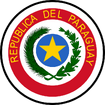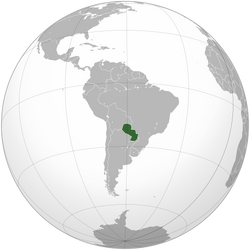|
República del Paraguay | |

|

|
| Motto Paz y justicia | |
| Anthem Paraguayos, República o Muerte | |
| Capital | Asunción |
| Government | Presidential republic |
| President | |
| - From 2008 | Fernando Lugo |
| Legislature | Congress |
| - Upper house | Senate |
| - Lower house | Chamber of Deputies |
| History | |
| - May 15, 1811 | De facto |
| - September 10, 1880 | recognized by Spain |
| Area | 406,752 km² |
| Population | |
| - 2009 | 6,349,000 |
| Density | 15.6/km² |
| GDP | 2009 (PPP) |
| - Total | US$ 29.8 billion |
| - Per capita | US$ 4,700 |
| Currency | Guaraní |
| v | |
The Republic of Paraguay is a presidential republic in South America.
Background
Paraguay achieved its independence from Spain in 1811. In the disastrous War of the Triple Alliance (1865-70) - between Paraguay and Argentina, Brazil, and Uruguay - Paraguay lost two-thirds of all adult males and much of its territory. The country stagnated economically for the next half century. Following the Chaco War of 1932-35 with Bolivia, Paraguay gained a large part of the Chaco lowland region. The 35-year military dictatorship of Alfredo STROESSNER ended in 1989, and, despite a marked increase in political infighting in recent years, Paraguay has held relatively free and regular presidential elections since then.[1]
Economy
Landlocked Paraguay has a market economy distinguished by a large informal sector, featuring re-export of imported consumer goods to neighboring countries, as well as the activities of thousands of microenterprises and urban street vendors. A large percentage of the population, especially in rural areas, derives its living from agricultural activity, often on a subsistence basis. Because of the importance of the informal sector, accurate economic measures are difficult to obtain. On a per capita basis, real income has stagnated at 1980 levels. The economy grew rapidly between 2003 and 2008 as growing world demand for commodities combined with high prices and favorable weather to support Paraguay's commodity-based export expansion. Paraguay is the sixth largest soy producer in the world. Drought hit in 2008, reducing agricultural exports and slowing the economy even before the onset of the global recession. The economy fell 3.8% in 2009, as lower world demand and commodity prices caused exports to contract. The government reacted by introducing fiscal and monetary stimulus packages. Growth resumed at a 14.5% level in 2010, the highest in South America. Political uncertainty, corruption, limited progress on structural reform, and deficient infrastructure are the main obstacles to growth.[2]
President
- Fernando Lugo (₩) (August 15, 2008 - )
Nation
Paraguayan Polities
Viceroyalty of Rio de la Plata
Neighbouring Nations
References
- Country Studies: Paraguay (Library of Congress)
- Paraguay: Guide to Law Online (Library of Congress)
- The World Factbook (CIA)
- Chiefs of State and Cabinet Members of Foreign Governments (CIA)
- U.S. Department of State
- Australian Government
- Inter-Parliamentary Union - Senate
- Inter-Parliamentary Union - Chamber of Deputies
- BBC News Country Profile
- BBC News Time Line
- World Statesmen.org
- International Constitutional Law Project
- Psephos Election Archive
- Wikipedia
